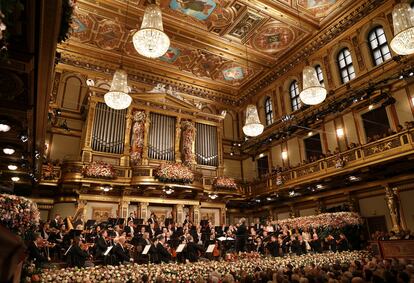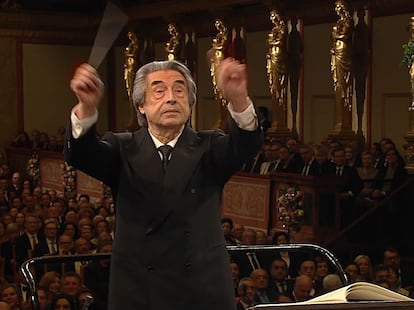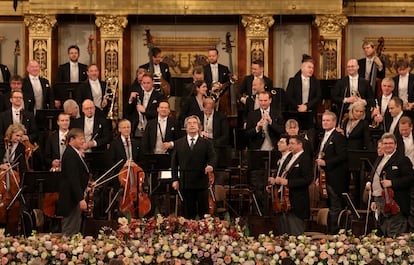“Classical music does not concern an elite of fans or connoisseurs, but is a good that belongs to everyone,” Riccardo Muti insisted at the beginning of his latest book, Hidden harmony (in Italian), published by the publisher Rizzoli in 2024. And he exemplifies it with the Comedy from his admired Dante, who at the end of Canto His seventh appearance at the head of the Vienna Philharmonic’s New Year’s Concert has been a true lesson in how to understand what an orchestra needs to enthrall audiences with the marches, polkas and waltzes of the Strauss family and their contemporaries.
Muti’s last performance at the helm of this popular musical event, in 2021, was completely different. He performed with the Viennese orchestra in front of a golden hall of the Musikverein empty due to the pandemic. A difficult experience that he faced successfully thanks to his excellent relationship of more than five decades with the Vienna Philharmonic, as he recalled a few days ago in the Vienna newspaper Delivery man: “Together we imagined that the room was full and that helped us.” The only advantage that concert had for Muti was the possibility of directing the Marcha Radetzky without having to pay attention to the audience applauding too loudly or at the wrong time. But this year his interpretation of the popular final piece by Johann Strauss Sr. has regained the warmth, solemnity and joy that was missing in 2021.
Muti, at 83 years old, lives a personal love affair with the Vienna Philharmonic. With him on the podium, we have been able to see and hear that metaphor of the orchestra as an ideal image of a civilized society, which he comments on in his aforementioned book, by uniting very different people in the desire to achieve a common goal. Under his precise instructions, full of smiles and knowing glances, the Vienna Philharmonic becomes the perfect vehicle to transmit that peace, brotherhood and love that he alluded to, in Italian, during his New Year greetings. The prestigious Austrian orchestra responded to the occasion with a more traditional program and with greater musical interest than in recent years, although it also included five works that Muti already conducted in his first four performances at the head of the New Year’s Concert, in 1993, 1997 , 2000 and 2004.
The start, with the freedom marchby Johann Sr., linked to the revolutions of 1848, already showed some glimpse of that combination of demand and complicity with the orchestra. He then conducted an admirable version of the exquisite waltz Austrian Barn Swallowsby Josef Strauss, full of dynamic details and fluidity in the management of tempo, where the clarinetists Matthias Schorn and Andreas Wieser stood out. Muti’s ability to mark both the details and the spirit of the music with his whole body continued in the Demolition Polkaby Johann Jr., where he exhibited complicity with concertmaster Volkhard Steude in this refined portrait of the workers who demolished Vienna’s old fortifications to build its famous Ringstrasse.
The musical interest of the first part did not decline in the Lagoon Waltzby Johann Jr. This medley from his operetta One night in Venicewith which Muti opened his New Year’s Concert in 2000, sounded more inspired now. The spark did not fade in the unattractive fast polka either. Light and fragrantby Eduard, the youngest of the Strausses. Precisely, the documentary film of the intermission starred his great-great-grandson, Thomas Strauss, who acted as the commander of a spaceship in a nod by Barbara Weissenbeck to the famous sequence with music by Johann Strauss Jr. in 2001: A Space Odyssey. An attractive futuristic evocation of the life of the king of the waltz, in celebration of his 200th anniversary, with several performances starring members of the Viennese orchestra, although with the strange decision of adding music by the Englishman Benjamin Britten as a disruptive element instead of some example of the members of the Second Vienna School.

The second part began with another great performance of the operetta’s overture The Gypsy Baronby Johann Jr. Another lesson from Muti when it comes to musically opposing the Hungarian and the Viennese, which left aside the last interpretation by Christian Thielemann, in 2019, although without reaching the elevation of Carlos Kleiber, in 1992. The two ballet scenes, choreographed by Cathy Marston and costumed by Patrick Kinmonth, were an aesthetic display exquisitely harmonized with the surroundings, both at the Südbahnhotel in Semmering (in the waltz Accelerationsby Johann Strauss Jr.) as in the impressive steam locomotive 12.10 of the Vienna Technical Museum (in the polka The… theby the same composer, where we saw the Salamanca dancer Andrés García Torres).
Muti brought out all the musical juice in the two novelties of this edition of the New Year’s Concert. In addition to the march happy brothersby Joseph Hellmesberger Jr., performed the first work by a female composer scheduled for this popular musical event: the Fernando’s waltzwritten in 1848 by child prodigy Constance Geiger. But the quality leaned toward the last four compositions on the program, with two brilliant and varied interpretations of the famous Ana’s Polka y Polca Tritsch Gossipby Johann Strauss Jr., respectively, a tribute to his mother and a mockery against the fake news published against him in 1858 in the Viennese satirical weekly Gossip Gossip. The waltz was not far behind either. Transactionsby Josef Strauss, which Muti already directed in 1993, but the best came again with Johann Jr. and his waltz Wine, women and songswith that imposing symphonic introduction halfway between Mendelssohn and Wagner, which the Italian director exquisitely connected with the waltz sections.

With the audience and the Viennese orchestra devoted to his baton, the tips were another highlight of the matinee. And after the theatrical audacity of The BayadereMuti directed his best performance of the popular Next to the beautiful blue Danubeby Johann Jr., which Michael Beyer’s precise television production seasoned with interesting musical details, after showing us in the rest of the concert the most hidden decorations of the golden hall of the Musikverein. In 2026, Canadian conductor Yannick Nézet-Séguin, head of the Philadelphia Orchestra and the Metropolitan Opera in New York, will make his debut conducting the New Year’s Concert. Since 2010 he has collaborated with the Vienna Philharmonic and has already conducted, in 2023, its popular summer evening concert in the Schlosspark of Schönbrunn Palace.

